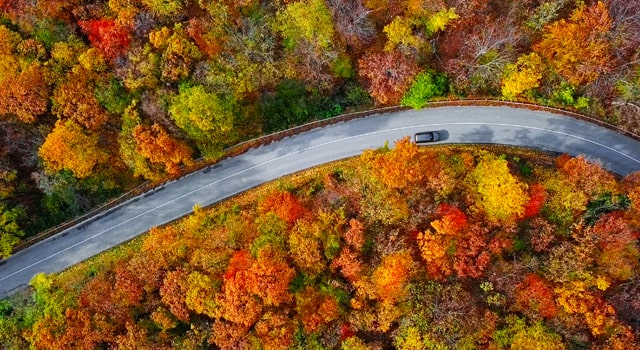Crisp days filled with breathtaking foliage, fire pits and pumpkin picking — what’s not to love about fall? However, unpredictable changes in weather, fallen leaves, and the end of daylight saving time can all lead to challenging driving conditions that last into winter. These fall driving safety guidelines can help keep you and others safe.
Where did the road go?
As you’re enjoying the scenery, be mindful of the road – it may suddenly vanish. It’s not uncommon for heavily wooded back roads to completely or partially disappear under fallen leaves.
If your view of the road becomes obstructed by leaves, slow down enough to get your bearings. Avoid slamming on your brakes. If you’re around other drivers, increase your following distance to give yourself more time to react.
Piling up
As folks clean up their yards, those giant piles of leaves can sometimes spill onto the road and conceal hazards. It’s easy for leaves to cover up potholes, large branches, animals and sometimes even children playing in them.
It’s best to resist any urges to drive through piles of leaves – it could turn into a mountain of problems. Parking on piles of leaves can also be an issue, as heat from your car could potentially spark a fire.
Slippery as ice
Fall rains and heavy morning dew can make leaves on the road as slippery as ice. Plus, that cool fall air can lead to frosty mornings and icy spots on the road, particularly on bridges and in shady spots. Later into the season, black ice also becomes a concern, which is hard enough to see without a layer of leaves covering it up.
Slow down if you’re driving in wet fall conditions, especially on those back roads. Consider building some extra time into your drive so you don’t have to rush it.
Sun glare
The sun will be lower in the sky during the rush hours this time of the year, which means sun glare could be an issue for drivers. It’s not uncommon for the sun to blind drivers, causing unexpected traffic slowdowns.
Keep a good pair of sunglasses in your car (but take them off before it gets too dark) and have your sun visor ready to use.
Oh deer!
Deer mating season begins in late October and lasts through November. That means deer in rut may become more active than usual and lose awareness of their surroundings. Plus, loud noises and flashing lights can cause unpredictable behavior and startle deer to run into traffic.
Be extra mindful when you see deer crossing signs and while driving through wooded areas. Slow down if you spot a deer farther down the road. Since they typically travel in herds, one deer is usually followed by more.
Prep your car
As the weather cools off, take this time to give your car a check-up. Make sure your tires are in good shape- that means inspecting the tread wear, air pressure and age. Don’t forget about your spare!
Clean your windshield both on the inside and outside, and replace your windshield wipers if needed. If your headlights seem too dim, ask your mechanic to check that they’re aligned properly. Now is also a good time to winterize your car.
Now let’s talk about you
Do you have the right coverage for your vehicle? We’d love to chat with you about it. Call us at 800-516-9242 or speak to a local agent.
If you’d rather not talk, you can get a quote quickly and easily online. Just enter your ZIP code to get started and see how much you could save!

